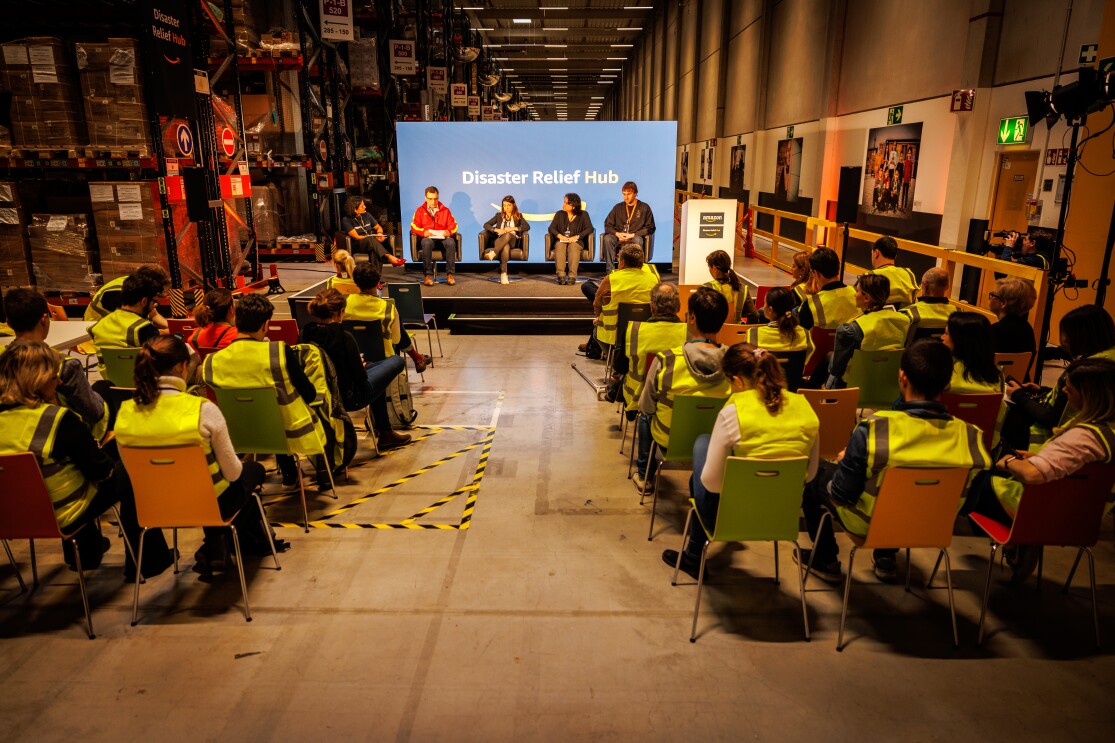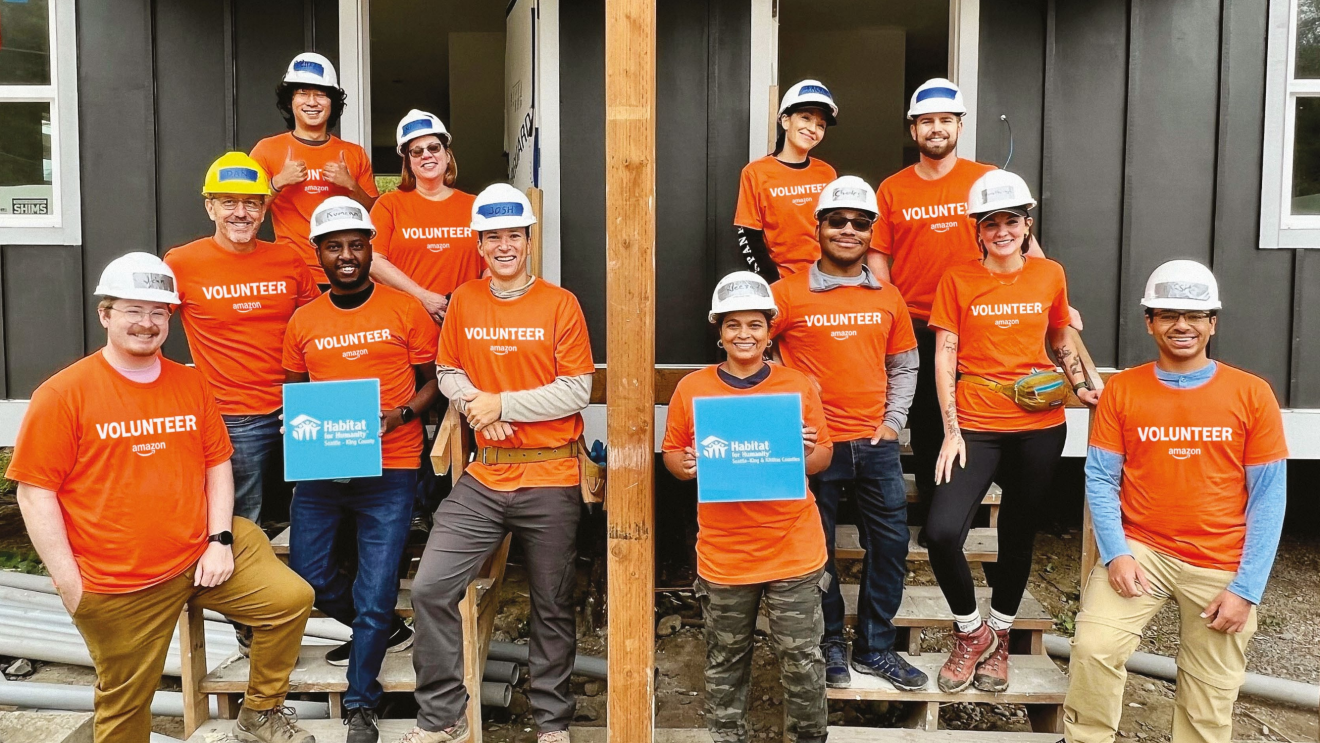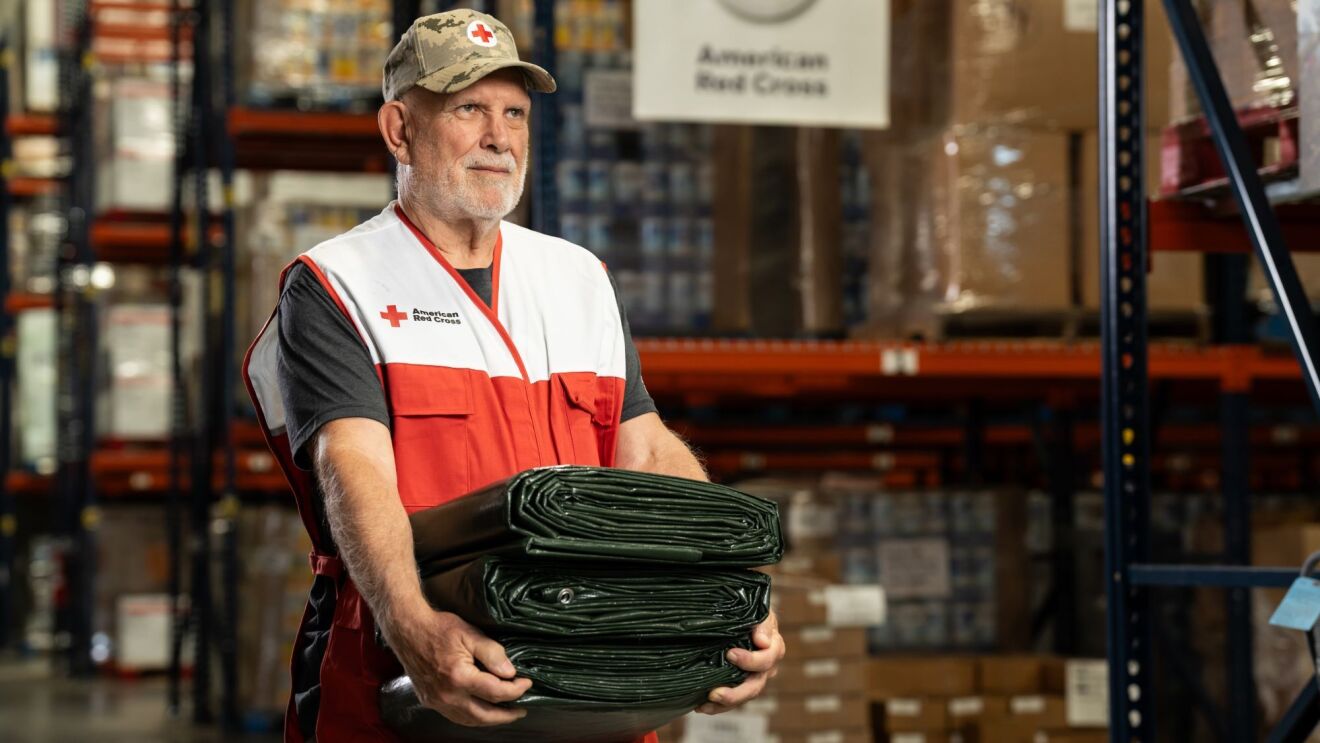Amazon has opened our first Disaster Relief Hub in Europe. We will fill the hub with 1,000 pallets of relief items, enough to fill a Boeing 737 plane 20 times, and will use our global logistics network to send critical products to nonprofits and community partners in the wake of natural disasters. The Disaster Relief Hub is a dedicated space within our global logistics network where we can store and quickly pack items that are most needed following damaging storms, earthquakes, wildfires, floods, and other emergencies. It is located in our fulfilment center in Rheinberg, Germany, an area with easy access to major international airports and transport networks.
 Bettina Stix, head of Amazon Disaster Relief, speaks at the Disaster Relief Hub opening.
Bettina Stix, head of Amazon Disaster Relief, speaks at the Disaster Relief Hub opening.“Today, natural disasters happen more often and are increasingly more severe—and we’re mobilizing our global inventory, logistics infrastructure, and technology to support the communities impacted by these emergencies. We’re committed to use our scale and passion for invention for good,” said Bettina Stix, head of Amazon Disaster Relief. “We’ve partnered with local and international relief organizations to understand their needs and we’ve looked at our data to identify the most-demanded products in the aftermath of natural disasters. With the opening of this new Hub in Germany, our response to disasters across Europe, the Middle East, and North Africa will be even faster and more efficient.”
The more than 21,000 square foot Hub area will be ready to respond to Europe’s most common natural disasters, including floods and forest fires. The items stored include sheltering supplies (such as tents, blankets, cots, mats, sleeping bags), hygiene kits (such as soap, toothbrushes, and toothpaste), and cleaning items (such as working gloves or cleaning supplies). We have analyzed the data that shows the kind of products requested after each natural disaster since 2017, and found that more than 80% of the needed items are the same following each major natural disaster. These include diapers, tarps, cots, blankets, heaters, tents, and cleaning supplies.
 Fireside chat with relief partners and Amazon employees on previous disaster relief experiences.
Fireside chat with relief partners and Amazon employees on previous disaster relief experiences.Using our own data and forecasts from relief organization partners, our teams have millions of relief items on hand, ready to be packed and deployed to impacted communities when needed. Having a dedicated facility where these items are ready to be shipped allows Amazon to send help in less than 72 hours, much faster than if teams had to pack the products and consolidate across different facilities throughout the continent.
Successful partnerships with relief organizations
We work with national and international relief organizations year-round, including the Red Cross, Save the Children, and the International Organization for Migration (IOM) to understand their needs and be ready to source the products that they demand in advance. Thanks to this collaboration, we have responded to more than 145 natural disasters across the world since 2017, and have donated more than 24 million relief items.
"The establishment of this hub marks a significant milestone in our ongoing collaboration, and I am thrilled about IOM becoming a strategic partner in such a crucial initiative. Our collective work throughout these couple of years in disaster relief and emergency operations has been fruitful, laying a strong foundation for our future joint efforts," said Jeanette Camarillo, deputy director for the Department of Humanitarian Response and Recovery at IOM.
"For seven years, Amazon and Save the Children have been supporting children and their families facing disasters worldwide," said Gabriella Waaijman, Save the Children's global humanitarian director. "The new Disaster Relief Hub is a monumental next step in Amazon's commitment to this work. It harnesses Save the Children's decades of humanitarian expertise and Amazon's leading supply chain to ensure that in the aftermath of a natural disaster or emergency, essential items such as hygiene kits and learning materials reach the people who need them the most, as quickly as possible."
 Maurice "Mo" Ramsey, senior manager of AWS Disaster Response and Humanitarian Affairs.
Maurice "Mo" Ramsey, senior manager of AWS Disaster Response and Humanitarian Affairs.In addition to donating products and logistics services, Amazon has also made it easy for customers to donate products through our online stores. When the Russian invasion of Ukraine started, customers from across Europe used Amazon to send thousands of products to relief partners for distribution to displaced Ukrainian families.
In just the last 18 months, we have responded to natural disasters across the world, including wildfires in Chile, Colombia, Australia and Hawaii, earthquakes in Japan, Türkiye, Syria, and Morocco, and hurricanes and cyclones in Puerto Rico, Florida, and India.
Improving disaster response through cloud technology
Our support during natural disasters goes beyond using our vast logistics to deliver items quickly to the impacted areas. Amazon Web Services (AWS) is helping organizations use the power of cloud computing to improve disaster response. For example, AWS is working with the American Red Cross to better serve communities by innovating cloud computing-enabled solutions, including powering Alexa-enabled devices to receive hurricane alerts and to schedule blood donations.
AWS also has a dedicated Disaster Response team that helps standby partners—including relief organizations, government entities, and nonprofits—prepare for and respond to disasters globally using cloud technology. This includes testing proof-of-concepts and fine-tuning existing innovations under simulated disaster conditions like using AWS Disaster Response vehicles to deploy connectivity networks after internet and telecoms infrastructure is severely damaged. These vehicles are enabled with powerful and portable cloud computing devices designed for rugged deployments in the harshest physical environments.
AWS has used cloud technology to help partners with mapping and damage assessment of hard-hit areas, re-establishing internet connectivity, and scaling call centers to handle increased requests after a disaster. The team also provides computing power for responding organizations in the field to process information on-site, enabling them to make faster decisions about where to focus response efforts.
Recently, AWS provided cloud technology and expertise to support teams fighting wildfires in Chile, Colombia and Maui. Using cutting-edge technology, crews were able to understand the extent of the damage caused by the fires and to monitor and confirm new hot spots and to track new fires. Teams also used the aerial surveillance images to generate maps for decision-making and preventative responses efforts.
Trending news and stories












